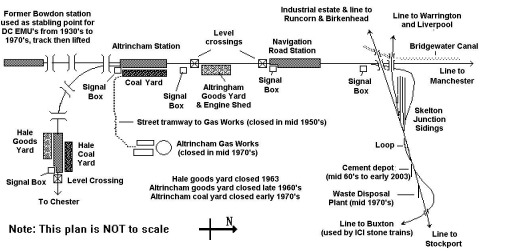
| < Return to index page |
Appendix Five: Hale Station - Cheshire Lines Committee
NB Please note this section is in very rough form, my notes are currently in storage. The sketches used for illustration are NOT scale drawings. More, and better, photographs are to be added to this page, once I get time to sort through, scan and scale them. I am deeply indebted to the members of the uk.railway and uk.rec.models.rail newsgroups who have provided a great deal of the information used in this section.
Facilities and Trackplan
Hale Station on the former Cheshire Midland (Midland Railway, Cheshire Lines Committee) line between Altrincham and Chester opened as 'Bowdon Peel Causeway' in 1862, renamed 'Peel Causeway' in 1899 and 'Hale' in 1902. At the Manchester end the line had running powers over the Manchester South Junction & Altrincham Railway, allowing trains to run into Manchester (terminating at Manchester Central station) or to divert via the CLC complex at Skelton Junction to carry on to Liverpool, Stockport (and the main LNWR line to Manchester) or Warrington. At the Chester end it reached Chester Northgate station. Local passenger services from Manchester Central (Midland Railway) were withdrawn in 1967 however alterations to the tracks approaching Manchester enabled the former CLC Liverpool via Warrington and Chester via Northwich services to run to Oxford Road or Piccadilly from 1969. Manchester Central was closed in 1969, for a time it was used as a car park but was then redeveloped as the Greater Manchester Exhibition and Events Centre (G-Mex) in 1986.

Fig : Area Map
Given the proximity of the large station at the nearby market town of Altrincham the facilities at Hale, the first station on the line to Chester, might seem rather extensive. This station served not only the local urban population but also a great many farms and even some smaller local industries and off loading in Hale avoided the busy streets of the town. Hale has been used elsewhere in this document to illustrate a range of points from track formations to signalling, however it is perhaps worth reiterating the basic track plan.

Fig : Hale Station Track Plan
We are frequently told to avoid S curves on model railway layouts, and I have heard these described as unprototyical, however the line between Altrincham and Hale follows a lengthy left hand curve then does a very tight S curve. This allows us to add such curves, and justify them, when fitting the layout onto a single baseboard such that the station is inset to allow for the two sidings on the cattle dock side. The curves would be the mirror image of those on the prototype (shown below), the bridge shown on the right hand end of the track plan above is just out of sight beyond the far curve.
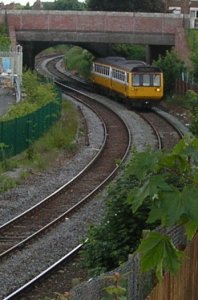
Fig : Track approaching Hale Station
The traffic on this line has been quite varied, although seldom what one might call intensive. There are passenger and freight services on the line and occasional light engine movements as well, with a wide range of motive power being used. The line has always been favoured by 'specials' of various kinds, since the end of steam traction on BR it has regularly been used for steam-hauled excursions, of late these have featured Black Five haulage, and usually guarantee a good turn out at the station.

Fig : Black 5 'steam special' at Hale 2006
More modern engines have also been used for 'specials' on this line, including (in the 1980s) 50007 Sir Edward Elgar in commemorative green livery, D200 (40122) in full green livery (with original BR totem) in 1986, 33025 in Engineers livery in 1995, a pair of EWS liveried Class 37s in 2003 (leading engine was 37042) and 67019 in EWS livery heading the Waverley Express in 2004.
Hale Signal Box and Signalling
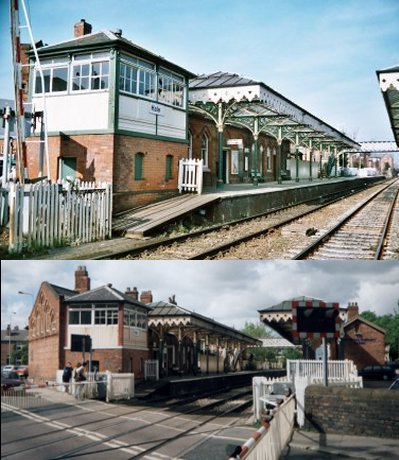
Hale Signal Box (disused)
The box at Hale resembles a Midland design (for which see the Airfix/Dapol Oakham signal box) but whereas almost all the Midland boxes were of all wood construction the box at Hale has a brick base (this is not simply a brick covering as was added to some boxes during World War Two to provide additional protection against bombing). Most boxes built by the CLC prior to 1904 had hipped roofs (with some gable roofed exceptions, including one or two on this line), the box at Hale is the standard hipped type. The signal box is located at the end of the to-Manchester platform, with the former 'gents' tucked in behind, so unlike many similar boxes there was on 'earth closet' and the steps were arranged down the side of the box, toward the platform edge, rather than leading away from the box. The stairs were wooden and were not boxed in in any way (although obviously there was a handrail).
I am not certain of the colours used on the signal box in CLC days however the MR used a yellowish cream for the woodwork with white window frames. In the BR era the original standard was red corner posts and beams, a cream colour called light biscuit for the panelling or planking, and white window frames. In the 1960s this changed to a rather military looking dark green in place of red for the corner posts and beams. In the BR era the name plate on the signal box (where fitted) would be an enameled metal plate with the regional colour background and the box name in white, this changed in the post 1964 'Corporate' colour scheme to a white metal plate with the name in black, however the basic building colours seem to have remained unaltered (Hale box today (2007) is still in the BR green and cream colours, as are the various signal boxes still in use at either end of Stockport station).
At the time of writing there is a rather interesting photograph of Hale level crossing, taken I believe in about 1905, on the web site of the Hale Civic Society . Click on the link for Origins of Hale Civic Society in the left hand menu. The picture is interesting in many ways, the box has no name plate on the front and the gates themselves are not as seen on most model railways. The gates are asymmetrical, each side having one long and one short gate, supported by tall rectangular posts about nine feet high for the longer end, seven feet at the shorter end. The taller posts carry a flattened pyramid capping stone above which rises a four foot cast metal post carrying a lantern or lamp (similar in appearance to the nearby gas street lights). On other crossings on the line there were four lanterns, one on each post as shown in the sketch. The gates themselves reach a height of about five feet above the roadway and in the photograph they do not appear to be painted white (they are rather darker than the posts, possibly red). There is a porter in the photograph standing by the gates, suggesting they are hand operated, but I believe his job was to stop traffic so the gates could be closed using a wheel mounted inside the signal box. I believe these asymmetrical gates remained in operation until the crossing changed to lifting barriers in the early 1980s. Also on the photo the platform mounted starter signal for the line to Chester can be seen, mounted on a very substantial (foot-square) signal post. In the background of the photo can be glimpsed Smedley's brewery, home of a brew known locally as 'Smedley's Purge'.
The road crossing was slightly unusual in that it was skewed and not at right angles to the tracks, so a little surgery would be required to use a commercial level crossing kit if the model is to be accurate. This may have some connection with the use of asymmetric gates but I am not sure about that. The centre sketch shows the gates as I remember them in the 1970s, I believe the large lantern mounted above the 'bullseye' on the longer gate was always painted red (this was certainly so in the 1970s). The bottom sketch below shows a standard pair of symmetrical gates, some of these had taller posts with angled rods similar to those on the longer Hale gates.
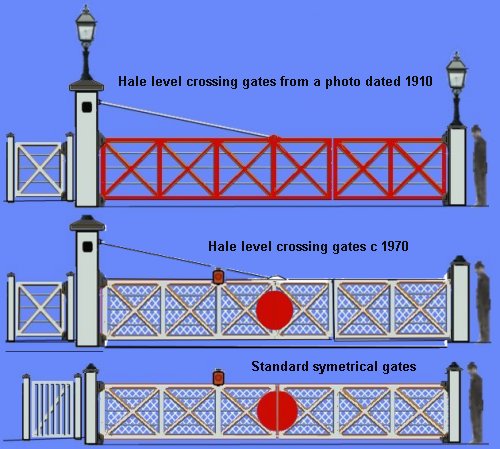
Fig : Level crosFigsing gates at Hale station
One of the problems with the old style level crossing gates was that the signalman had no means of stoping the traffic on the road, he had to wait for an appropriate moment to start closing the gates. This was one of the reasons for changing to lifting barriers, fitted with traffic lights and a warning siren, bell or horn. At first the barriers installed at Hale had an electric bell to indicate they were about to close, this was changed to a two-tone horn after complaints that people in the local pubs were fooled into thinking it was 'last orders'.
The signal box at the crossings in Hale did not control the goods yard, the points and ground signals used in the yard were operated from a ground frame in a hut about eight feet long by six feet deep with gabled roof located close by the connection with the running lines. The hut in the photo below was close by the ground frame but rather more substantially built, it may have served as a mess room for the yard staff. Note the tall signal beside it, the photo was taken in about 1984 shortly before the signals were replaced with BR standard types.
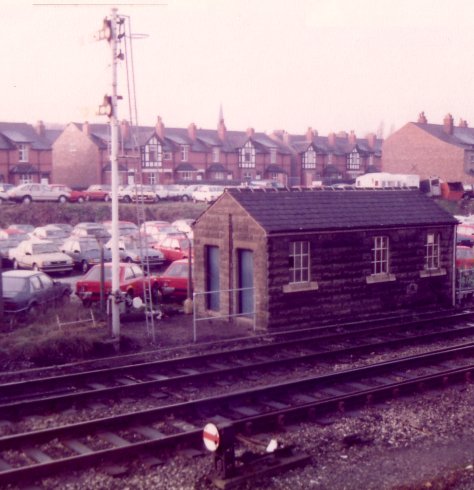
Fig : Tall signal mast at Hale in 1984
One curiosity at Hale was a 'sky signal' (a signal on a very tall lattice mast) on the Manchester side of the station beyond the cattle dock which could be seen my the driver of a train from Manchester coming round the curve and under the road bridge. This signal had a low-mounted repeater arm as it was very tall and would be difficult to see let alone read when the train drew close. Because of Health and Safety regulations all these tall masted signals were replaced by a standard British Railways upper quadrant semaphore on a nine foot tubular post in the mid 1980ís, and then the whole section was converted to colour light signalling in the early 1990ís.
The photo below shows the full-disc ground signal that used to control the cross-over at Hale in the early 1980s.
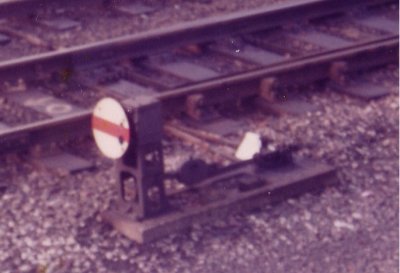
Fig : Ground signal at Hale in about 1984
Hale signal box was finally closed in July 1991, at the same time as Altrincham North and Navigation Road boxes, under the SSI re signalling scheme for Deansgate Junction in preparation for Metrolink. Mobberley also lost its frame in favour of a panel at the same time.
I asked on the uk.railway newsgroup and Kevin Allsop advised there were photos of a similar box on -
Signalbox.org/mobberley The base is slightly different but the basic design is the same and the interior does look very like my memory of the interior of the Hale box. One point though, as I remember it the Hale box had brown wooden cased instruments right to the end of its life, not the black BR plastic cased examples shown in the Mobberley box.
Passenger Facilities at Hale
There are two platforms, each long enough to take six Mk3 coaches (I counted the coaches of a diverted express held up at Hale en route to London). The original platforms were rather shorter, perhaps long enough for four coaches, but these were extended at some point. There were no bay platform facilities, although there is a track on the non goods yard side which could be made a bay if required by the modeller. This could be for providing a commuter service into Manchester and would use the single slip to cross onto the appropriate line at departure. In reality I believe this track served as both an end-loading dock and also a shunting spur to handle the rakes of horseboxes at the small cattle dock at busy times. Commuter traffic on the line was substantial into the 1970s and might reasonably justify a bay platform (especially if the services using the bay ran via Skelton Junction to Stockport and thence to Manchester). The main station buildings and the station masters house are on the Manchester platform, with the signal box beside the level crossing and the Gents tucked in behind this (the Gents had a series of large louvered openings on the outer wall, visible in the photographs). As the road crosses the line at an angle the Gents wall is also at an angle, adding some interest to the shape of the buildings.
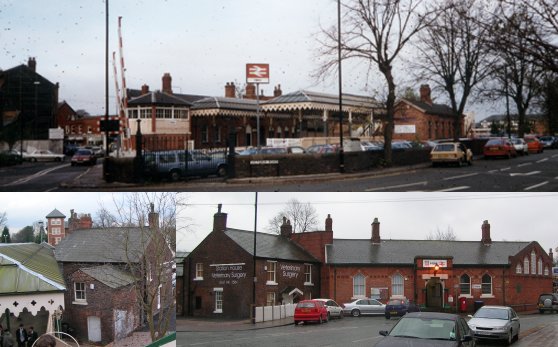
Fig : Hale station main building and station master house
At the opposite end of the main building from the signal box is the station masters house, built at an angle to the main buildings as the road outside curves at this point. The main station building has an angled end wall at this end as well, in line with the station masters house, so although there are four windows and a double entrance door on the street side there are five windows and two additional doors on the platform side.
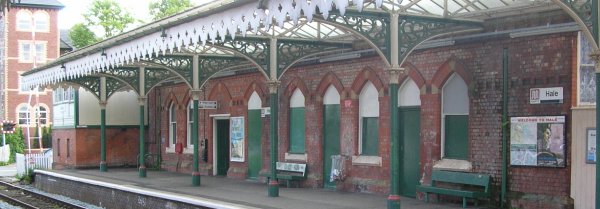
Fig : Hale station main building platform side
On the Chester side there is a smaller but still substantial building and connecting the platforms is a steel lattice footbridge. Until about the 1970s this foot bridge was covered and it used to extend across the adjacent yard to the roadway. Although the area adjacent to the Chester platform is marked on maps as a coal yard there was (in about 1910) an extension to the platform canopy at the level crossing end, suggesting a facility for handling perhaps parcels or possibly milk churns. No trace of that extension now remains.
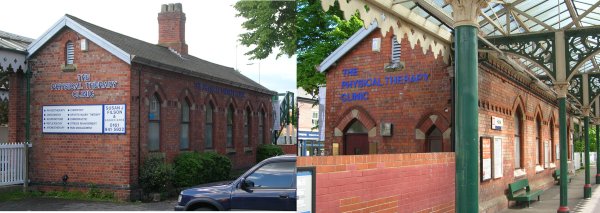
Fig : Hale station secondary building
As noted above the footbridge originally had an additional span reaching across the yard to Victoria Road. Hence there are four supports at the end on the Manchester platform but on the Chester platform there were originally two supporting the stair side and a single support on the other side. When the bridge was shortened (in the later 1960s I believe) a simple steel girder was added to provide a fourth 'leg' at this point. I believe that the roof and side windows were removed from the footbridge at this time.
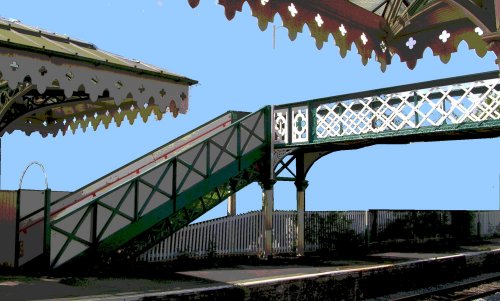
Fig : Hale station footbridge
One curious feature is the ornate plate inserts at the ends of the span close by the stairs. There is a metal hoop at the foot of each staircase, mounted on raised posts. I suspect this originally supported a gas or oil lamp but today it has no function.
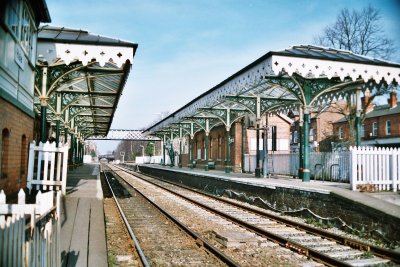
Fig : Hale station (line from Altrincham to Chester on the right)
Both platforms are equipped with ornate canopies which have remained well maintained to the present day. The photo below shows one of these as seen from the footbridge.
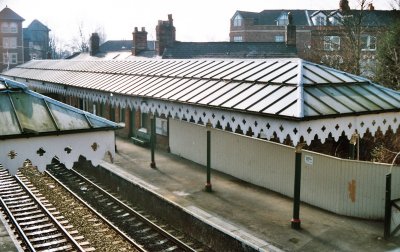
Hale station canopy
On the real canopy there is a distinct greenish tinge to the top side due to moss or something of that ilk growing on the glass. The tall wooden wall at the rear of the platform encloses the station masters garden.
Goods Facilities at Hale
According to the British Transport Commission's 1956 Station Handbook (see Links page, British Railways in the Manchester Area website) Hale was equipped to handle a considerable range of goods. This included General Goods Traffic, either accessed by road vehicles from sidings in the open or via the goods shed. The cattle dock was suitable for live stock such as cattle and sheep, the local polo club saw regular visits by horse boxes and I gather there was an occasional Prize Cattle Van.
Goods trains might also deliver Furniture Vans, Carriages, Motor Cars, Portable Engines and Machines, on Wheels. The crane, mounted inside the goods shed, could handle 5 ton loads. There was a coal yard by the station master house, and I have seen references to the area on the cattle dock side being used for coal (as shown on the sketch). The station also saw what the commission describes as; Passenger, Parcels and Miscellaneous Traffic including Carriages and Motor Cars by Passenger or Parcels Train. I can find no reference to an end-loading dock at Hale, however I believe the two tracks feeding the area marked 'coal yard' may be involved. I suspect that the shorter track may have run up to a raised area of ground, allowing for end-loading. This makes sense in that it would be eminently sensible as a 'carriage shoot'. The line that curves round the outside of this area may have been used for loading coal carts, I have seen a photograph of a local traders wagon at the end of that line (where the ground level is at track level.
The goods yard was closed in (I believe) 1968, traffic being passed to the yard at Altrincham.
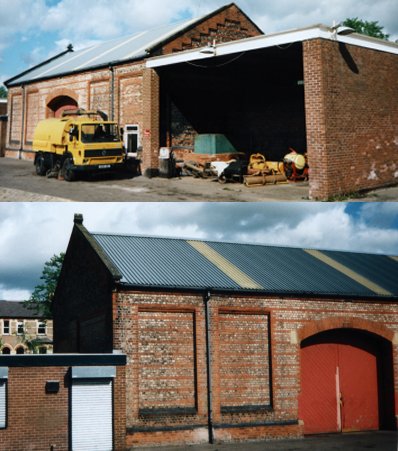
Fig : Hale goods shed (in use as corporation depot mid 1980s)
I have only a couple of photos of the rear of the shed, difficult to photograph because of the trees and bushes along the road side opposite and the sun usually being on the far side. The example below is the best I could find, again taken after the Corporation had added the extension to one end of the building.
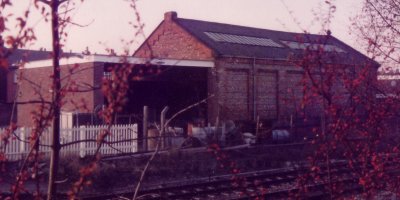
Fig : Hale goods shed rear elevation
Services and Stock
Passenger Services
There were regular passenger trains from Chester to Manchester (Central Station, now the GMEX centre). There was at one time a daily train to London from Hale, departing in the early morning, although I am not sure of the details. Two coach push-pull services were a regular feature from the 1930s until the end of steam, under BT the engine was usually a BR 'Mickey Mouse' 2-6-2 of the type formerly offered by Minitrix. Diesel multiple units were introduced fairly early in this area, the first DMU services starting in about 1960, but steam hauled trains continued for peak times into the 1960s. By the early 1970s the Manchester to Chester service usually consisted of two car Class 101 sets providing an hourly service in each direction. By a quirk of timing these trains have often crossed at Hale. The train stopped at all stations from Chester to Altrincham, then ran as an express between the Oilerkon electrics on the Manchester South Junction &Altrincham Railway line to Manchester stopping only at Sale before reaching Manchester. Originally the trains terminated at Central Station in Manchester, after the closure of that station they were routed to Manchester Oxford Road (from whence many continued on, providing regular services to Blackpool, Wigan and presumably other destinations).
In 2003 there was a shortage of DMUs for the line, leading to a short lived loco-hauled service consisting of two Fragonset Class 31 locomotives top and tailing four Mk 2D coaches in BR Intercity livery.
Trains have always used the line as a diversion, especially when work was underway on the West Coast Main Line. During the WCML electrification work in the spring of 1958 the Manchester to Bournemouth 'Pines Express' was diverted via Hale, usually hauled by a Jubilee class locomotive. This service normally ran from Crewe via Stockport to Manchester but during the diversion after leaving Crewe it turned left at Sandbach forward via Middlewich to join the CLC line at Northwich where it turned right then forward via Hale then Altrincham. It then ran on the Manchester South Junction &Altrincham Railway line to Deansgate Junction where it turned off and skirted the sidings at Skelton Jcn, then ran on to Stockport where it re joined the line to Manchester. I understand this diversion it added 50 minutes to the journey time. There have also been a number of 'specials', some run by enthusiast groups (which continue to run into the present day (2006) as well as special trains for events such as important football matches in Manchester and the like. The Venice Simpleon Orient Express rake of Pullman coaches, hauled behind a pristine Class 47 in white roofed BR Large Logo livery, ran a Valentines Day special in the early 1980s, shortly after their reintroduction in 1982. The steam specials run for enthusiasts has been a feature of the line, justifying the running of any (preserved) engine type hauling a mixed bag of coaches in various liveries (one such train had at least one crimson and cream brake with other coaches in 'intercity' blue and white), you need a minimum of about six coaches behind such an engine (the current series in the first years of the 21st century have favoured eight coach trains which can be accommodated at the stations on the line). Although most steam specials are hauled by large express engines the NRM's preserved 0-6-2 LNWR 'coal tank' engine has run at least one excursion on the line.
Goods Traffic on the Line
There was a daily stopping goods service through Hale until the later 1960s (Hale goods yard closed in 1968). There was also a daily milk train to Manchester, running inwards in the early morning, from another branch line to Winsford (again joining the mid Cheshire line at Cuddington). Milk churn traffic was collected from stations on the line into the 1950s, possibly the 1960s.
There was a twice daily parcels train run between Crewe and Manchester, calling at Knutsford and Altrincham on the way, although not stopping at Hale. The rake typically comprised only a couple of vans, this service lasted into the later 1960s.
A nearby polo club generated horse box traffic at intervals, the dock at Hale would require a lot of shunting to handle this traffic. I understand that the long siding on the cattle dock side of the station, although mainly used by local coal merchants, was used to store the boxes. There may well have been special trains (more likely coaches attached to scheduled trains) bringing the participants and spectators.
Hale is on the Mid Cheshire line and due to a lack of turntables on the line there was always a fair bit of tender-first running. The line formed part of the Cheshire Lines Committee system and the CLC handled a lot of freight; there were steelworks at Irlam near Manchester and on the river Dee near Chester, large chemical works were built around Northwich in central Cheshire and at Widnes on the bank of the Mersey. All of these generated traffic and received considerable quantities of Lancashire coal and broken limestone from the Peak District. The docks in Liverpool and Manchester provided plenty of traffic and the line between Liverpool and Manchester carried considerable goods traffic. At the Manchester end Britain's first and largest industrial estate at Trafford Park contained a great range of manufacturing industries. Nearby the CWS built a large soap factory served by the CLC and in 1922 an oil refinery opened at Stanlow on the south bank of the Manchester Ship Canal. A subsidiary industrial park built alongside the Bridgewater canal at Broadheath (on the Altrincham-Manchester line just North of Hale) would also generate a range of traffic.
There was a branch from the line through Hale (closed in the mid 1930s) from Cuddington to Whitegate and Winsford, where there were extensive works belonging to the Salt Union.
Other notable industries served included the Brunner Mond (formerly ICI Mond Division) soda ash works at Northwich set up in the 1920s. This single industry with its need for tons of limestone every day has been a mainstay of the line and still generates much of the freight traffic today (2007).
As ICI had arrangements to use only East Midlands coal there were regular long coal trains running on the line to feed the many chemical plants. There were regular long coal trains well into the diesel era, many hauled by Class 40 engines and comprised mostly of 12 ton and 16 ton wagons (comparatively few coal hoppers seem to have used the line).
The heavy limestone trains from the quarries of Buxton going to the chemical works in Cheshire are a feature of the line. Wagons used for this traffic were originally large numbers of traditional wooden bodied open wagons, quite a number of (Midland Railway designed) CLC three plank types but also large numbers of private owner five plank open wagons operated by Buxton Lime Firms and Brunner Mond Chemicals. In the mid 1930s these two companies merged with Nobel Industries, British Dyestuffs Corporation and United Alkali Company to form Imperial Chemical Industries (the largest chemical company in the world until it was de-merged in 1992).
ICI continued to operate large numbers of five plank open wagons for transporting the limestone but in the mid 1930s they began building a fleet of large vacuum braked bogie hoppers. These wagons operated on a merry-go-round system long before Mr Beeching (who had worked for ICI) introduced the idea for coal trains. The vacuum braked hoppers operated as 'block trains' carrying limestone from Tunstead in the Peak District to Northwich in Cheshire. After loading at Tunstead (opened in the 1920s) the hoppers were left for a couple of hours on a siding where they were checked and maintained before beginning the return journey. The hoppers were built by Charles Roberts, vacuum brake fitted throughout their life and a fleet of over 150 were built in the later 1930s running on diamond frame bogies. After the war additional wagons were ordered to the same basic design but fitted with plate frame bogies, increasing their payload somewhat, in the early 1950s a final batch was ordered, again with plate frame bogies but also with some small differences in the body. A typical hopper train, up to the 1960s, would be between five and ten hoppers, in the 1970s there was a move toward fewer longer trains and the class 25 engines were replaced by large locomotives or ran double-headed. In the mid 1980s the original hoppers had their diamond frame bogies replaced by plate frame bogies, increasing their payload slightly.
The ICI hoppers were originally painted all over black and had ICI on the side in the form of welded on metal letters picked out in white. After the war the official colour was all over light grey, again with ICI picked out in white but the only examples I ever saw were an all-over rust and track dust brown colour. They were coded PHV under the TOPS system after 1974 and they had numbers prefixed ICI, following the de-merger of ICI in 1992 the prefix changed to BLI (Buxton Lime Industries).
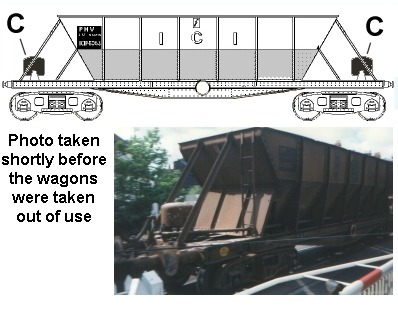
Fig : ICI Hoppers showing location of vacuum cylinders
Rumours of their demise were circulating for some time, their bogies were reportedly approaching the end of their working life in the late 1980's, but it was early 1998 before they were finally replaced by rakes of four wheeled PGA hoppers hired from CAIB. These proved problematic in this traffic however, the dust blown off the wagons attracted complaints and the shift to much higher axle loadings on the modern wagons cause serious vibration problems on the un-welded track. The final solution was to weld the track and, from late 2000, employ much larger JEA bogie hoppers.
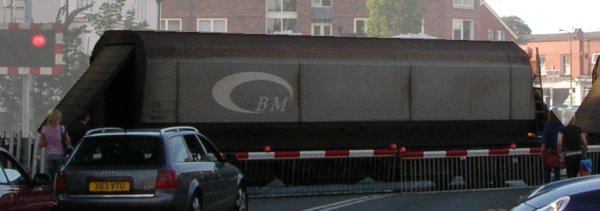
Fig : Brunner Mond hoppers in 2006
The ICI vacuum braked hoppers are not available in any form for N gauge, although a kit is available for OO. The PGA hoppers are available as ready to run in N from Farish and the N Gauge Society offers its members a suitable kit for the more modern bogie types.
The limestone hopper trains were a characteristic sight passing through Hale, I believe there were typically three trains a day in each direction on this service even after the longer trains were introduced, but other freight working have always been a feature of the Mid Cheshire line.
Soda ash was a regular cargo, often making up an entire train, by the later 1970s the stock was cream liveried four wheel tank wagons, similar to the Peco long wheelbase 'gas tanker' model, these were powder wagons not liquid tanks. Most trains operating from the Stanlow oil refinery only used the southern part of the line, but modellers licence would allow some oil workings even into the block-train era.
Rock salt in BR standard metal bodied tarpaulin wagons (unsheeted I believe) was shifted every autumn from the later 1960s (perhaps before). In the early 21st century trains of large ribbed-body bogie tippler wagons carrying fly as from power stations were using the southern parts of the line, these travel unsheeted and leave a faintly visible cloud in the air as they pass.
In the 1990s there was a Thursdays only Holyhead to Humber petroleum coke "empties" which passed along the mid-Cheshire line in the late morning, there were I believe two trains a week, each consisting of a short rake of large bogie covered hoppers (typically I believe about five hoppers) but most of these ran at night. This service came to an abrupt end following a fire at the Humber Oil refinery at Killingholme, Lincolnshire in about 2002. The refinery was the only British source of the petroleum coke used by Angelsey Aluminium at Holyhead, this material is now imported from the USA.
Also on the line in the 1990s I recall seeing short rakes (as many as ten but sometimes as few as three) of four wheel depressed centre powder tanks and very long rakes of empty MGR hoppers. I asked on the uk.railways newsgroups and was informed that the powder tanks would be the Enterprise freight service to/from Warrington Arpley yard to Peak Forest and Dowlow nr Buxton. I gather that in 2005 rakes of four or five large bogie covered hoppers were used for this traffic (as well as the four wheeled tanks) hauled by a single Class 66 or a pair of Class 37 engines. The MGRs (which I had thought were doing driver training services) could either be to or from Earles Sidings for Hope Cement works or from Healey Mills/Yorkshire area. I have since seen rakes of loaded HAAs pass along the line.
There was also apparently a train of empty flat wagons run from Mostyn on the North Wales coast to Healey Mills in the morning as well.
During track renewal work around Stockport there were regular trains of bogie ballast hoppers (long rakes of Seacow types on one occasion) and four-wheel spoil wagons. Works at Stockport also required the diversion of the Northenden 'binliners' through Hale. I also remember seeing the occasional long rake of what I believe were rail-carrying wagons run through the station. One late afternoon in 2005 I saw a Fragonset liveried Class 33 (black with yellow panel below the front windows and a red stripe, outlined in white, between the doors) hauling a lengthy rake of assorted empty coaches. The coaches were apparently in good condition although most were still in pre-privatisation liveries.
Locomotives and Multiple Units Seen on the Line
I gather the Midland Railway operated a number of passenger services on the line, I have not yet managed to confirm the make up of these trains but a likely candidate would be a 2-2-2 'Spinner' hauling perhaps a five coach train providing an express service. There is a photograph of a Midland 0-6-4 tank (I believe this was a Deeley 0-6-4T commonly know as a Flatiron, 40 were built in 1907 but all were withdrawn by 1938). Another photo shows a LNWR 2-4-2 tank hauling a regular passenger service to Crewe which included a through coach to London in the rake. The LNWR operated two types of 2-4-2 tank, introduced in 1979 and 1890.
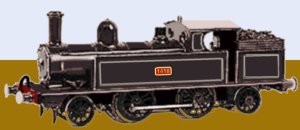
Given the interrelationship of the GNR, MR and GCR in this area it seems likely that all three companies would have sent engines along the line as part of their goods services rather than change engines. The GCR Class 9K 4-4-2 tanks were regulars on passenger duties, some were fitted for push-pull working in the early 1930s. Introduced in 1902 and becoming Class C13 under LNER ownership the forty engines of this class were initially based in the London area, some being transferred to Manchester for suburban duties in the early 1930s. Withdrawals started in the 1950s and the last, based in Manchester, was withdrawn in 1960.
Following the Grouping in 1923 the line would have seen both LMS and LNER engines on freight duties but I believe the passenger side was generally GCR hauled into the 1950s, with 9L/C13 engines in regular use. Some LMS tanks were also used on the line and locomotives from the former North Staffordshire Railway operated in this part of the world and it is likely that occasional examples would have passed through Hale. There is a photograph of the station (dated 1955) showing an ex GCR GCR Class 11E 'Director' 4-4-0, LNER class D10 number 62662 'Prince of Wales' hauling a passenger service.
The DMUs appeared in about 1960 (some people think it may have been as early as 1958), displacing steam from passenger duties on the line. The Class 101s soon became the mainstay of passenger services although other classes of DMU were also used on the line. The rakes varied, during peak times up to six coach units (three two coach units operating in multiple, often of different classes), normal off-peak services consisted of a two, occasionally three, coach set. The 101s proved a long lived breed, one of the last to go was 'Daisy', a two car 101 unit repainted in its original BR green livery which operated in the South Manchester area (including on the Chester services) until late December 2003. The 101s were progressively replaced in the early 1980s by a range of multiple units, principally the rather less successful Class 142s.
Interspersed with the 142s the line has seen a wide range of multiple units employed, including 'heritage' 1st generation units and the more modern classes 150, 151 and 152 and a range of liveries including BR Provincial livery (still seen occasionally in 2006), Liverpool Metro yellow and Strathclyde red! Occasionally post privatisation multiple units have run in multiple, usually two different classes running together, usually in different liveries.
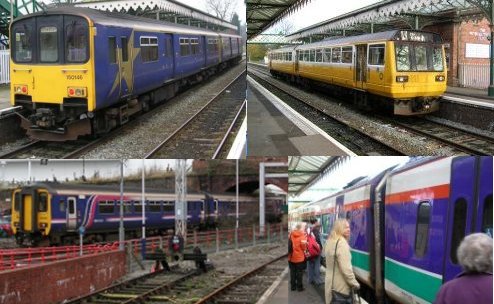
Fig : Hale - post-privatisation multiple units
Note the photo in the bottom left was taken at Altrincham, the train in question was arriving from Hale, the photo bottom right shows a Strathclyde Transport liveried DMU at Hale in 2006.
General freight trains were hauled by a range of LNER and LMS locomotive types. The ICI hoppers were initially operated in 11 wagon rakes hauled by 4F class locos but from 1938 Class 8F locomotives took over the haulage duties, hauling up to 17 loaded wagons. During the war the empties were often hauled by LNER J39 class 0-6-0s due to a shortage of the heavier engines. In the later 1950s ex War Department 8F engines were occasionally used and BR standard 9F types were also trialed, hauling up to 19 wagons, however the older 8F remained the mainstay of the services until the diesels took over.
Diesels typically hauled 20-25 ICI hoppers in a rake, although rakes as short as five hoppers with a brake van were seen behind a single class 25 in the 1960s. Engine types used for the limestone trains included classes 24, 25, 28, 44, 45 and 46 with most trains hauled by Class 25s until the later 1970s when more class 40 and 45 traction was seen as longer trains became the norm. In the early 1980s class 47s were often used and in the mid 1980s pairs of class 20s coupled nose to nose were a regular feature and for a time a dedicated pool of these engines was used, but they were found to have problems and by the later 1980s pairs of Class 37s were the norm (with the occasional single Class 47), more modern engines, such as the class 56, could not run with the old hoppers as they lack air brakes.
The CAIB PGA wagons were hauled by a single Class 56 or pairs of Class 37's and the new JEA wagons saw Class 66 and Class 60 haulage in the first year or so of operation although at first rakes were only 17 or so wagons. By 2006 the standard limestone train was a rake of 20 to 25 JEA bogie wagons (carrying close to 1500 tons of limestone) hauled by a Class 60 locomotive, the service consisting of only one or two trains a day.

Fig : EWS Class 60 in 2006
Enterprise services in 2005 were hauled by EWS Class 66s and Freightliner green Class 59s. Light engine movements have included Class 37s, 47s, 59s and 66s. Other goods trains operating on the line but as yet unidentified have included a short train of a single bogie tanker (cargo unidentified) and three container flats each carrying one or two 'beam tank' containers.
| ^ Go to top of page |
International Good Guys ~ Making the world a better place since 1971
All material Copyright © Mike Smith 2003 unless otherwise credited